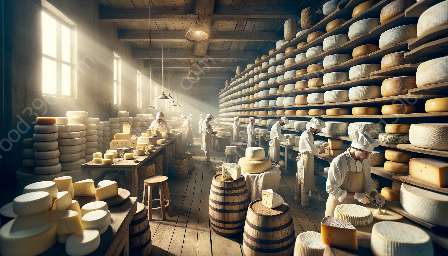Cheese coagulation and curd formation are integral processes in the art of making cheese, with relevance to food preservation and processing. This topic cluster delves into the scientific principles and practical applications of these processes, providing a comprehensive understanding of cheese making and its broader implications.
Understanding the Basics
Coagulation and curd formation are fundamental steps in cheese making, involving the transformation of milk into a solid mass through the action of coagulants and the separation of curds from whey. These processes are crucial for achieving the desired texture, flavor, and shelf life of cheese, making them essential aspects of food preservation and processing.
The Science Behind It
The coagulation process is initiated by the addition of coagulants such as rennet or acid, which lead to the coalescence of milk proteins and the formation of a gel-like structure known as the curd. This process involves complex biochemical reactions, including the interaction of casein micelles, calcium ions, and enzymatic activity, all of which contribute to the transformation of liquid milk into a solid mass.
Role in Cheese Making
Cheese coagulation and curd formation directly impact the quality and characteristics of the final product. The type of coagulant used, the temperature, pH, and duration of coagulation, as well as the manipulation of curds, all influence the texture, flavor, and meltability of the cheese. Understanding these processes is essential for creating a wide variety of cheese types, each with its unique attributes and applications in food preservation and processing.
Relevance to Food Preservation
The coagulation and curd formation processes are closely tied to food preservation, as cheese making historically served as a method of preserving surplus milk. By transforming perishable milk into a stable and flavorful product, cheese making allowed communities to store and consume dairy products over extended periods, contributing to their sustenance and well-being.
Processing Implications
Not only do cheese coagulation and curd formation facilitate food preservation, but they also have broader implications for food processing. Understanding the intricate balance of biochemical and physical factors during coagulation enables the development of new cheese varieties, as well as the improvement of production techniques to meet consumer demands for quality, safety, and sustainability.
Modern Innovations
Advancements in cheese making techniques and the use of microbial coagulants offer new possibilities for producing cheese with enhanced nutritional profiles, reduced environmental impact, and extended shelf life. As the food industry continues to evolve, the understanding and manipulation of coagulation and curd formation processes are critical for innovating sustainable food preservation and processing methods.
Conclusion
From ancient traditions to modern innovations, cheese coagulation and curd formation remain essential processes in cheese making, while also bearing significance for food preservation and processing. This topic cluster provides a comprehensive exploration of the scientific, practical, and historical dimensions of these processes, illuminating their role in shaping the diverse world of cheese and contributing to the broader landscape of food preservation and processing.

